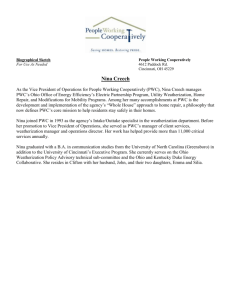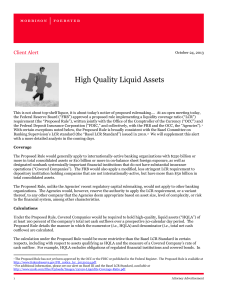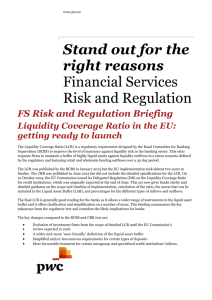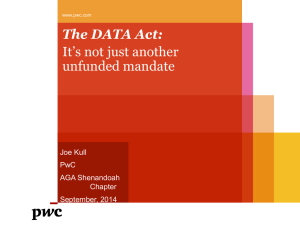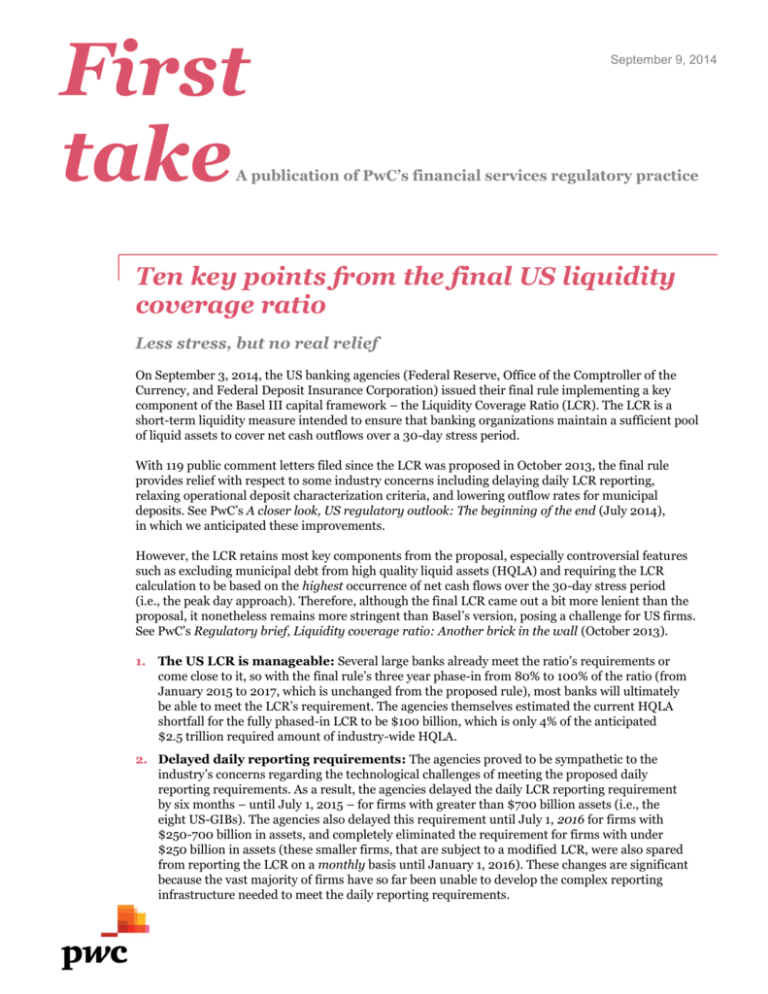
First
take
September 9, 2014
A publication of PwC’s financial services regulatory practice
Ten key points from the final US liquidity
coverage ratio
Less stress, but no real relief
On September 3, 2014, the US banking agencies (Federal Reserve, Office of the Comptroller of the
Currency, and Federal Deposit Insurance Corporation) issued their final rule implementing a key
component of the Basel III capital framework – the Liquidity Coverage Ratio (LCR). The LCR is a
short-term liquidity measure intended to ensure that banking organizations maintain a sufficient pool
of liquid assets to cover net cash outflows over a 30-day stress period.
With 119 public comment letters filed since the LCR was proposed in October 2013, the final rule
provides relief with respect to some industry concerns including delaying daily LCR reporting,
relaxing operational deposit characterization criteria, and lowering outflow rates for municipal
deposits. See PwC’s A closer look, US regulatory outlook: The beginning of the end (July 2014),
in which we anticipated these improvements.
However, the LCR retains most key components from the proposal, especially controversial features
such as excluding municipal debt from high quality liquid assets (HQLA) and requiring the LCR
calculation to be based on the highest occurrence of net cash flows over the 30-day stress period
(i.e., the peak day approach). Therefore, although the final LCR came out a bit more lenient than the
proposal, it nonetheless remains more stringent than Basel’s version, posing a challenge for US firms.
See PwC’s Regulatory brief, Liquidity coverage ratio: Another brick in the wall (October 2013).
1. The US LCR is manageable: Several large banks already meet the ratio’s requirements or
come close to it, so with the final rule’s three year phase-in from 80% to 100% of the ratio (from
January 2015 to 2017, which is unchanged from the proposed rule), most banks will ultimately
be able to meet the LCR’s requirement. The agencies themselves estimated the current HQLA
shortfall for the fully phased-in LCR to be $100 billion, which is only 4% of the anticipated
$2.5 trillion required amount of industry-wide HQLA.
2. Delayed daily reporting requirements: The agencies proved to be sympathetic to the
industry’s concerns regarding the technological challenges of meeting the proposed daily
reporting requirements. As a result, the agencies delayed the daily LCR reporting requirement
by six months – until July 1, 2015 – for firms with greater than $700 billion assets (i.e., the
eight US-GIBs). The agencies also delayed this requirement until July 1, 2016 for firms with
$250-700 billion in assets, and completely eliminated the requirement for firms with under
$250 billion in assets (these smaller firms, that are subject to a modified LCR, were also spared
from reporting the LCR on a monthly basis until January 1, 2016). These changes are significant
because the vast majority of firms have so far been unable to develop the complex reporting
infrastructure needed to meet the daily reporting requirements.
3. Only modest expansion of eligible HQLA:
Despite strong lobbying by both debt issuers and
banks, state and municipal debt remain excluded
from HQLA in the final rule, consistent with the
proposal. The agency board members indicated
when voting out the final rule that banks did not
hold a significant amount of such paper to be of
great concern to the debt market, although the
agencies indicated they would later consider a rule
proposal to allow some such instruments to qualify
as HQLA. Furthermore, the debt of Government
Sponsored Entities (GSEs) remains classified as
Level 2A despite its relatively liquid market and
continues to be subject to a 15% haircut and to the
overall Level 2 asset cap of 40% of HQLA. The only
expansion of HQLA that the final rule provided
relates to Level 2B securities (which are subject to a
50% haircut): corporate debt is no longer required
to be traded on a national security exchange, and
eligible equities are expanded to include those
within the more expansive Russell 1000 index
rather than limited to those just within the S&P
500. This expansion of eligible Level 2B assets is of
limited impact, compared to the much-hoped-for
changes relating to state/municipal obligations and
GSE debt that were not granted.
4. More realistic overall outflow rate
assumptions: Although the proposed rule
introduced the difficult requirement that banks
calculate net outflows based on the peak day
approach, the final rule somewhat ameliorated this
requirement by carving out those outflows that do
not have stated maturities. Therefore, instead of
assuming that these non-maturity outflows all occur
on the first day of the 30-day period, the final rule
assumes they occur within the 30-day period. This
improvement in the methodology acknowledges the
overly conservative and burdensome assumption
reflected in the proposal.
5. Improved definition for operational
deposits: The final rule addresses three major
industry concerns with respect to characterizing
items as “operational deposits,” so the items may
obtain a beneficially lower outflow rate (i.e., 25%)
relative to non-operational deposits. First, deposits
from financial firms are no longer disqualified from
being operational deposits unless the firms are
hedge funds, private equity funds, or certain other
less-regulated funds – a very big win for custody
banks that would have had great difficulty under the
proposed rule’s far more expansive disqualification.
Second, the proposal’s 30-day termination notice
requirement for an operational deposit is revised in
the final rule by making such account balance
necessary for the provision of operational services
and the termination notice period applicable to the
First take – PwC
binding agreement covering the performance of
such services. Alternatively, the presence of
significant contractual termination or switching
costs that would dissuade a customer from moving
to another bank would, along with other
stipulations, also allow the related deposit to qualify
as operational. These approaches are more realistic
and consistent with industry practice. Third, low
volatility is no longer a pre-requisite for
consideration as an operational deposit.
6. Lack of additional guidance on whether a
deposit is “operational” or “excess”: The
agencies continue to look to the industry to develop
methodologies to delineate excess deposits from
operational deposits – a significant challenge as
firms have not historically attempted to measure
operational balances and are still developing the
methodological infrastructure to do so. The
distinction between these two types of deposits is
important because a customer’s excess balances are
more likely to run off during a period of stress (and,
therefore, have a higher run-off rate ascribed to
them than do operational deposits). As regulatory
guidance for drawing the distinction, the final rule
merely offers that firms’ methodology should be
granular and take volatility into consideration when
determining excess balances. Banking organizations
will need to continue investing in techniques and
infrastructure needed to meet this critical
measurement challenge. See PwC’s A closer look,
Liquidity coverage ratio: No blood, but sweat and
tears (April 2014), for a suggested approach.
7. Relief granted for municipal deposits: Under
the proposed rule, municipal deposits were treated
similar to other secured funding transactions, which
the final rule remedied. The final rule addresses an
unanticipated consequence of the proposed rule’s
secured funding unwind provision (which was less
suited to the collateralization of municipal deposits,
a legal requirement in most US states). This change
in the final rule is a win for the several banks with
significant public deposits, and better reflects the
reality that municipal deposits are far less likely to
run off during times of stress than other secured
funding transactions.
8. Relaxation of “other” retail outflows: The
proposed rule included three categories of retail
funding (i.e., stable, less stable, and other – with
outflow rates of 3%, 10%, and 100% respectively).
The final rule maintains the “stable” and “less
stable” categories, but replaces their 100% outflow
category with less stringent ones, including:
(a) deposits placed by a third party that are not
brokered deposits and are FDIC-insured, which are
assigned a 20% outflow rate, and (b) other
2
unsecured deposits, including unsecured prepaid
cards, which are assigned a 40% outflow rate. These
changes represent a modest improvement in net
cash flow measurement under the LCR.
9. More details on undrawn commitments:
Although letters of credit were not mentioned in the
proposed rule, the final rule brings them under its
purview by clarifying that letters of credit must be
evaluated for possible inclusion as part of undrawn
credit and liquidity commitments. On the other
hand, the final rule affords some relief for undrawn
commitments to SPEs by restricting the punitive
100% outflow rate only to SPEs that issue securities
or commercial paper to finance their purchases or
operations. This “look through” approach was
lobbied for by the industry and will improve net
cash outflow measurement for these vehicles.
10. Nonbank SIFIs excluded: Nonbanks designated
as systemically important financial institutions
(SIFIs) are no longer included in the scope of the
LCR rule, evidencing the early stages of a potentially
less bank-centric approach that regulators are
attempting for nonbank SIFIs. Similar to the
Enhanced Prudential Standards final rule, the final
LCR indicates that the Federal Reserve may
establish LCR requirements for such companies by
individualized rule or order. See PwC’s, First take,
Enhanced prudential standards (February 2014).
First take – PwC
What’s next?
The finalization of the LCR rule marks a milestone, but it
is only the first step toward a comprehensive regulatory
reform program aimed at enhancing liquidity risk
management practices at US banks. The other leg of the
Basel III liquidity framework – the net stable funding
ratio (NSFR) – has yet to be proposed and is still under
development by the Basel Committee. We expect the
NSFR to have a more significant structural impact on US
banking organizations as it is designed to look beyond
the 30-day time horizon of the LCR. The NSFR’s
expected requirement that banks maintain stable
structural funding, along with an anticipated proposed
rule by US agencies incorporating the use of short-term
wholesale funding into the risk-based capital surcharge
applicable to US G-SIBs, will continue the regulatory
push to move bank funding toward more stable sources
such as retail and operational wholesale deposits.
3
www.pwcregulatory.com
Additional information
For additional information about PwC’s Financial Services
Regulatory Practice and how we can help you, please contact:
Dan Ryan
Financial Services Advisory Leader
646 471 8488
daniel.ryan@us.pwc.com
Shyam Venkat
Partner, Financial Services Risk Advisory
646 471 8296
shyam.venkat@us.pwc.com
David Sapin
Partner, Financial Services Regulatory Advisory
646 471 8481
david.sapin@us.pwc.com
Armen Meyer
Director of Regulatory Strategy
646 531 4519
armen.meyer@us.pwc.com
Contributors: Shyam Venkat, Stephen Baird, Kevin Clarke,
Daniel Delean, and Girish Adake.
To learn more about financial services regulation from
your iPad or iPhone, click here to download PwC’s new
Regulatory Navigator App from the Apple App Store.
Follow us on Twitter @PwC_US_FinSrvcs
© 2014 PricewaterhouseCoopers LLP, a Delaware limited liability partnership. All rights reserved. PwC refers to the US member firm, and may sometimes refer to the
PwC network. Each member firm is a separate legal entity. Please see www.pwc.com/structure for further details.
This content is for general information purposes only, and should not be used as a substitute for consultation with professional advisors. PwC US helps organizations
and individuals create the value they’re looking for. We’re a member of the PwC network of firms in 158 countries with more than 180,000 people. We’re committed to
delivering quality in assurance, tax and advisory services. Tell us what matters to you and find out more by visiting us at www.pwc.com/us.





